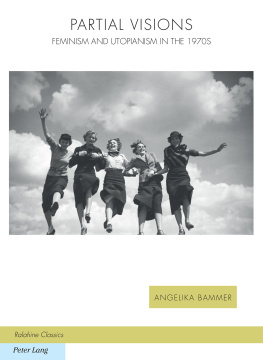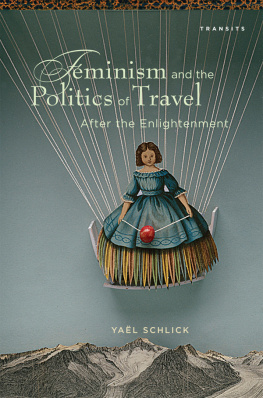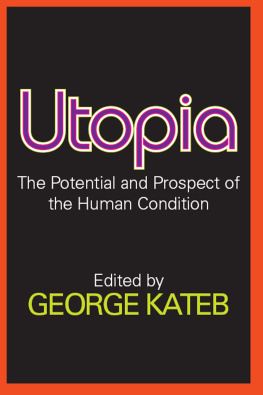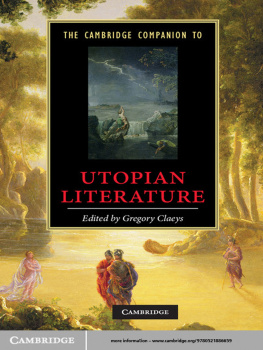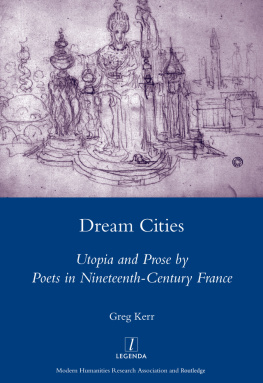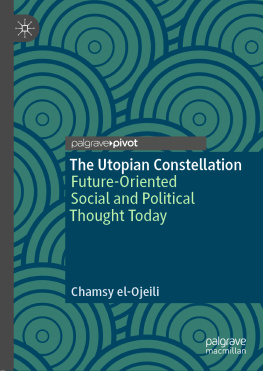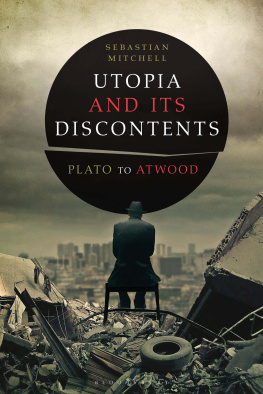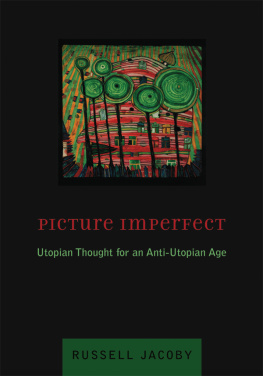Ralahine Utopian Studies
Series editors:
Raffaella Baccolini (University of Bologna at Forl)
Joachim Fischer (University of Limerick)
Michael J. Griffin (University of Limerick)
Naomi Jacobs (University of Maine)
Michael G. Kelly (University of Limerick)
Tom Moylan (University of Limerick)
Phillip E. Wegner (University of Florida)
Volume 16

PETER LANG
Oxford Bern Berlin Bruxelles Frankfurt am Main New York Wien
Angelika Bammer
PARTIAL VISIONS
FEMINISM AND UTOPIANISM IN THE 1970S

PETER LANG
Oxford Bern Berlin Bruxelles Frankfurt am Main New York Wien
Bibliographic information published by Die Deutsche Nationalbibliothek
Die Deutsche Nationalbibliothek lists this publication in the Deutsche Nationalbibliografie; detailed bibliographic data is available on the Internet at http://dnb.d-nb.de.
A catalogue record for this book is available from the British Library.
Library of Congress Cataloging-in-Publication Data
Bammer, Angelika.
Partial visions : feminism and utopianism in the 1970s / Angelika Bammer. Ralahine
classics edition
pages cm. (Ralahine utopian studies ; v. 16)
Includes bibliographical references and index.
ISBN 978-3-03-430897-7 (alk. paper)
1. Feminism and literature. 2. Utopias in literature. 3. European fictionWomen
authorsHistory and criticism. 4. European fiction20th centuryHistory and criticism.
5. American fictionWomen authorsHistory and criticism. 6. Women and
literatureUnited StatesHistory20th century. 7. Feminist fictionHistory and criticism.
I. Title.
PN3401.B36 2014
809.399287dc23
2014035268
Cover image: Toni Frissell, Five Women Running (1935).
ISSN 1661-5875
ISBN 978-3-0343-0897-7 (print)
ISBN 978-3-0353-0748-1 (eBook)
Peter Lang AG, International Academic Publishers, Bern 2015
Hochfeldstrasse 32, CH-3012 Bern, Switzerland
info@peterlang.com, www.peterlang.com, www.peterlang.net
All rights reserved.
All parts of this publication are protected by copyright.
Any utilisation outside the strict limits of the copyright law, without the permission of the publisher, is forbidden and liable to prosecution.
This applies in particular to reproductions, translations, microfilming, and storage and processing in electronic retrieval systems.
This publication has been peer reviewed.
14 | 15
Exempla
In 1405, a text that still stands as a landmark in the history of womens literature appeared on the cultural scene of western Europe: Christine de Pizans Le livre de la Cit des Dames [The Book of the City of Ladies]. Once again, as in her previous book, Le dbat sur le Roman de la Rose [Debate of the Romance of the Rose], Christine took up the issues raised by the dispute about women [the querelle des femme] that had been raging within French literary circles for well over a century. Conscious of the fact that hers was the only public womans voice in this debate, she did not content herself with a simple response this time, but presented her book as an antidote.
In many ways Le livre de la Cit des Dames is a very traditional text. Like Boccaccios De mulieribus claris [Of Famous Women] (c. 1362) and Chaucers The Legend of Good Women (c. 1385), it is a collection of exemplary tales about women. In the tradition of medieval didactic literature and courtesy books, Le livre de la Cit des Dames is written as an inspirational guide: good behavior is modelled through narrative exempla encouraging female readers to flee vice [and] cultivate virtue
Like the vision of paradise in Augustines De civitate Dei [The City of God] (c. 41326), a vision perhaps not unconsciously evoked in the echo of Christines title, Le livre de la Cit des Dames also depicts a perfect otherworld deeply steeped in and loyal to the hegemonic class and religious values of its time. At the same time, Christine rejects the authority of tradition from the perspective of gender. For the paradise she dreams of, unlike 15 | 16 that of Augustine, is an earthly one; she envisions not a state of God, but a city of women. In this respect, Le livre de la Cit des Dames prefigures a literature that was not to appear until well over a century later, a literature that presented readers with visions of other worlds in the hope of inspiring them to make changes in this one: the utopias of the European Renaissance.
In a manner that later utopias were to establish as generically typical, the text begins with the narrators astonishment at the strangeness of the familiar. Woman, she finds, is universally described as a vile and evil creature: the entire feminine sex [is represented] as though we were monstrosities in nature Thus equipped with the tools of her writerly trade, Christine goes to work. And as she writes, she constructs the City of Ladies.
Like the model cities designed by Italian Quattrocento architects, this too is a citt felice, a citt perfetta, a happy and perfect place. But with a difference. For this city of ladies is for women only. Gathered within its walls is a multitude of women (mythical, historical, and contemporary) who represent womens history. As their stories are retold and assembled into narrative form the fractured body of that history is re-membered; where nothing is remembered, that which might have been is imagined and set in its place.
Designed as a eu-topian good place and fictionally constructed as a ou-topian non-place, this city, like other utopias that were later to be written into literary history, is insular in both its physical and its conceptual design. Surrounded by a deep ditch and enclosed within high walls, it is a world unto itself, cut off from the outside world to which it stands in opposition. It is enabled and sustained by an act of separation: the old world (of men and their culture) has been left behind and a new world (of female culture) is presented in its stead. Yet this is not a utopia in conventional terms: a state, a polity, a commonwealth. It is not represented through institutional structures nor does it materialize in the form of cities with vast avenues, superbly planted gardens, countries where life is easy (Foucault 1973: xviii). Rather, it appears primarily as a narrative, as the record of stories, memories, and fantasies that could theretofore not be told. Instead of new institutions or new forms of government, it presents new ways of thinking about women and history: what they have been and could be. This is a utopia, then, in the most literal sense of the word: physically a non-place, it exists only in the form of a different state of mind.
In Varieties of Literary Utopias Northrop Frye explains that a typical utopian narrative is constructed as a guided tour: a visitor from another time and place visits the utopian world, is shown around, and in the end returns home. Since it is more or less insignificant whether the legal system or the table manners are presented first, there is no necessary or logical sequence to the narrative itinerary. In contrast to the linear dynamic of a novel whose coherence is based on a plot sequence of causally connected events, the narrative order of a utopia is random, its trajectory dialogic: 17 | 18 the narrator asks questions or thinks up objections and the guide answers them (26).

